Effective Communication Strategies for Nurses: A Comprehensive Report
VerifiedAdded on 2023/02/01
|12
|2580
|39
Report
AI Summary
This report delves into the critical role of effective communication in nursing, emphasizing its impact on patient safety, well-being, and the establishment of healthy nurse-patient relationships. The report explores various communication techniques, including active listening, open-ended questions, and the importance of non-verbal cues, while also addressing potential communication barriers such as language differences, cultural factors, and gender disparities. Through a case study analysis, the report demonstrates how effective communication can de-escalate challenging situations, improve patient comfort, and ensure appropriate healthcare delivery. Furthermore, the report discusses the interpersonal relationship theory and its application in nursing, highlighting the significance of trust, respect, and empathy in fostering positive patient outcomes. The report concludes with recommendations for enhancing communication skills through training, addressing staffing shortages, and promoting the use of communication tools to create a supportive and inclusive healthcare environment, ultimately improving patient satisfaction and the overall quality of care.
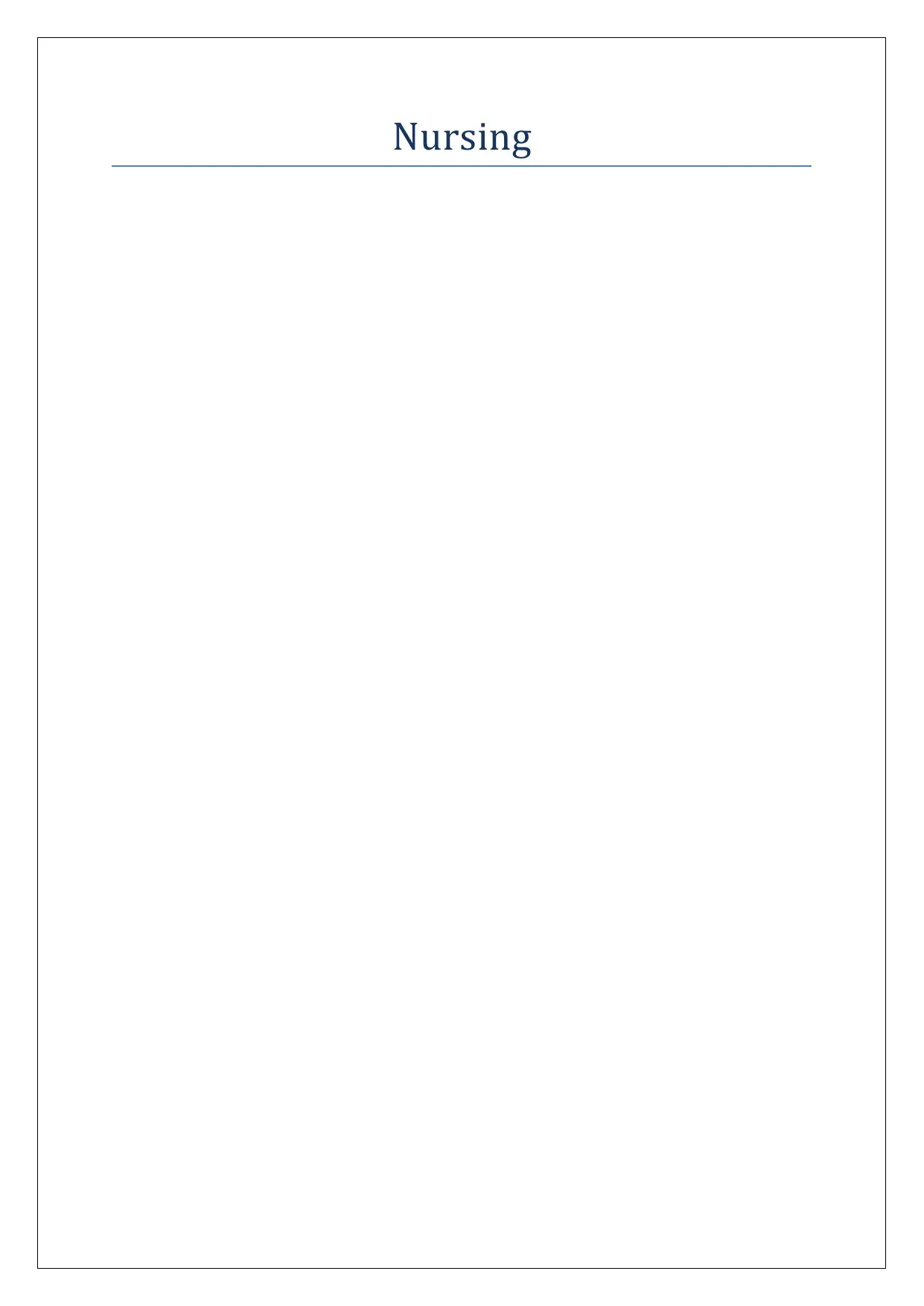
Nursing
Paraphrase This Document
Need a fresh take? Get an instant paraphrase of this document with our AI Paraphraser
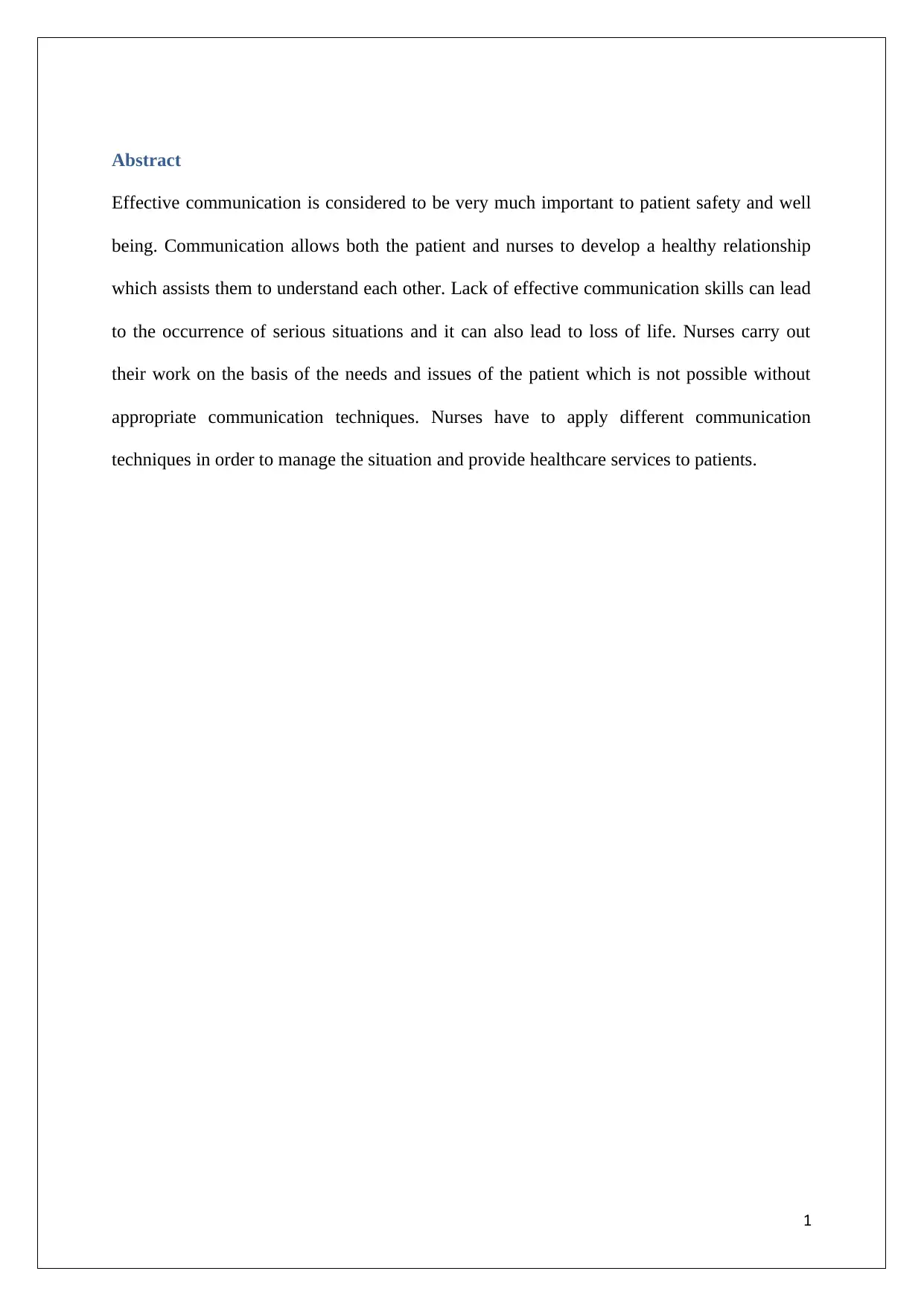
Abstract
Effective communication is considered to be very much important to patient safety and well
being. Communication allows both the patient and nurses to develop a healthy relationship
which assists them to understand each other. Lack of effective communication skills can lead
to the occurrence of serious situations and it can also lead to loss of life. Nurses carry out
their work on the basis of the needs and issues of the patient which is not possible without
appropriate communication techniques. Nurses have to apply different communication
techniques in order to manage the situation and provide healthcare services to patients.
1
Effective communication is considered to be very much important to patient safety and well
being. Communication allows both the patient and nurses to develop a healthy relationship
which assists them to understand each other. Lack of effective communication skills can lead
to the occurrence of serious situations and it can also lead to loss of life. Nurses carry out
their work on the basis of the needs and issues of the patient which is not possible without
appropriate communication techniques. Nurses have to apply different communication
techniques in order to manage the situation and provide healthcare services to patients.
1
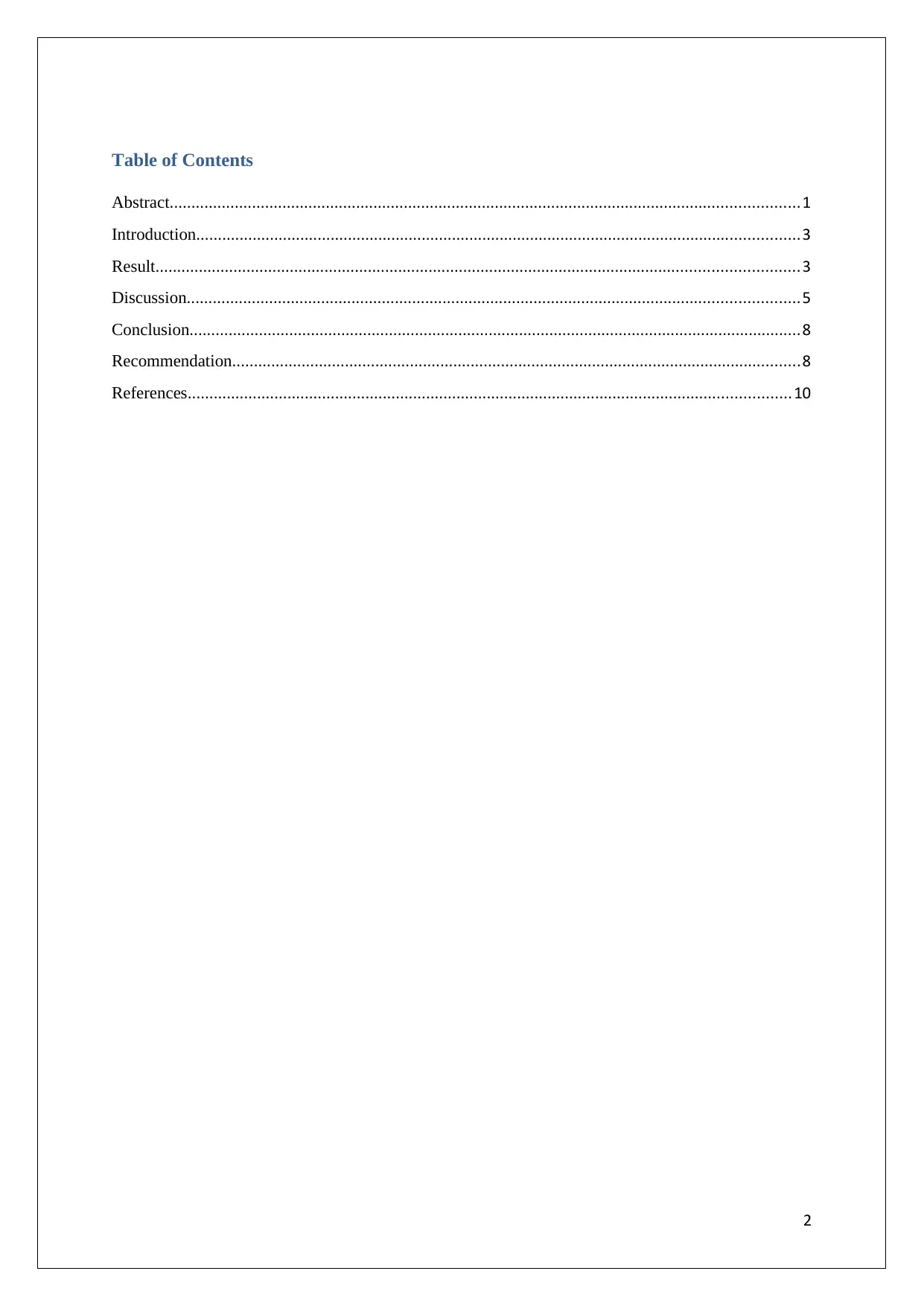
Table of Contents
Abstract.................................................................................................................................................1
Introduction...........................................................................................................................................3
Result....................................................................................................................................................3
Discussion.............................................................................................................................................5
Conclusion.............................................................................................................................................8
Recommendation...................................................................................................................................8
References...........................................................................................................................................10
2
Abstract.................................................................................................................................................1
Introduction...........................................................................................................................................3
Result....................................................................................................................................................3
Discussion.............................................................................................................................................5
Conclusion.............................................................................................................................................8
Recommendation...................................................................................................................................8
References...........................................................................................................................................10
2
⊘ This is a preview!⊘
Do you want full access?
Subscribe today to unlock all pages.

Trusted by 1+ million students worldwide
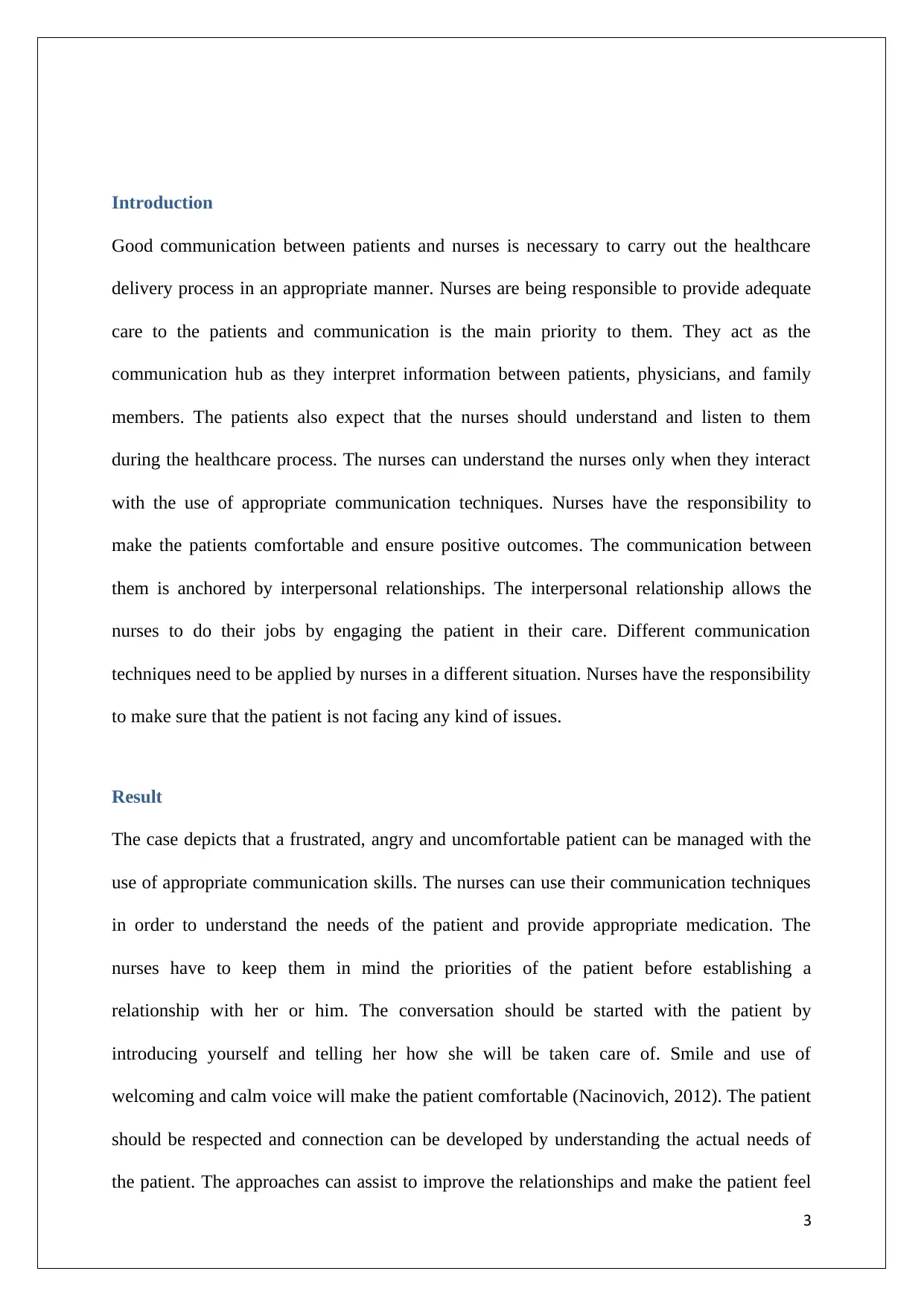
Introduction
Good communication between patients and nurses is necessary to carry out the healthcare
delivery process in an appropriate manner. Nurses are being responsible to provide adequate
care to the patients and communication is the main priority to them. They act as the
communication hub as they interpret information between patients, physicians, and family
members. The patients also expect that the nurses should understand and listen to them
during the healthcare process. The nurses can understand the nurses only when they interact
with the use of appropriate communication techniques. Nurses have the responsibility to
make the patients comfortable and ensure positive outcomes. The communication between
them is anchored by interpersonal relationships. The interpersonal relationship allows the
nurses to do their jobs by engaging the patient in their care. Different communication
techniques need to be applied by nurses in a different situation. Nurses have the responsibility
to make sure that the patient is not facing any kind of issues.
Result
The case depicts that a frustrated, angry and uncomfortable patient can be managed with the
use of appropriate communication skills. The nurses can use their communication techniques
in order to understand the needs of the patient and provide appropriate medication. The
nurses have to keep them in mind the priorities of the patient before establishing a
relationship with her or him. The conversation should be started with the patient by
introducing yourself and telling her how she will be taken care of. Smile and use of
welcoming and calm voice will make the patient comfortable (Nacinovich, 2012). The patient
should be respected and connection can be developed by understanding the actual needs of
the patient. The approaches can assist to improve the relationships and make the patient feel
3
Good communication between patients and nurses is necessary to carry out the healthcare
delivery process in an appropriate manner. Nurses are being responsible to provide adequate
care to the patients and communication is the main priority to them. They act as the
communication hub as they interpret information between patients, physicians, and family
members. The patients also expect that the nurses should understand and listen to them
during the healthcare process. The nurses can understand the nurses only when they interact
with the use of appropriate communication techniques. Nurses have the responsibility to
make the patients comfortable and ensure positive outcomes. The communication between
them is anchored by interpersonal relationships. The interpersonal relationship allows the
nurses to do their jobs by engaging the patient in their care. Different communication
techniques need to be applied by nurses in a different situation. Nurses have the responsibility
to make sure that the patient is not facing any kind of issues.
Result
The case depicts that a frustrated, angry and uncomfortable patient can be managed with the
use of appropriate communication skills. The nurses can use their communication techniques
in order to understand the needs of the patient and provide appropriate medication. The
nurses have to keep them in mind the priorities of the patient before establishing a
relationship with her or him. The conversation should be started with the patient by
introducing yourself and telling her how she will be taken care of. Smile and use of
welcoming and calm voice will make the patient comfortable (Nacinovich, 2012). The patient
should be respected and connection can be developed by understanding the actual needs of
the patient. The approaches can assist to improve the relationships and make the patient feel
3
Paraphrase This Document
Need a fresh take? Get an instant paraphrase of this document with our AI Paraphraser
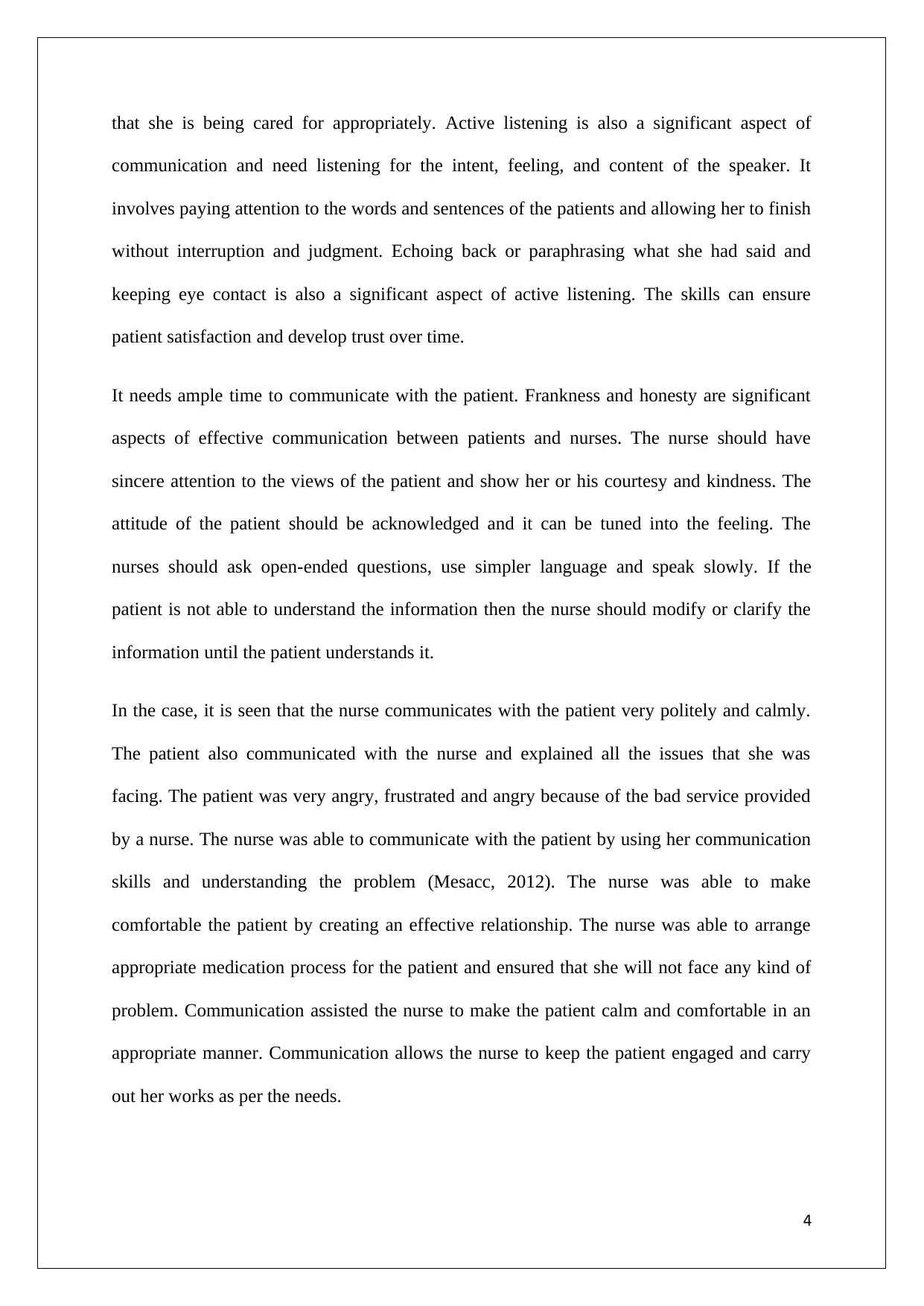
that she is being cared for appropriately. Active listening is also a significant aspect of
communication and need listening for the intent, feeling, and content of the speaker. It
involves paying attention to the words and sentences of the patients and allowing her to finish
without interruption and judgment. Echoing back or paraphrasing what she had said and
keeping eye contact is also a significant aspect of active listening. The skills can ensure
patient satisfaction and develop trust over time.
It needs ample time to communicate with the patient. Frankness and honesty are significant
aspects of effective communication between patients and nurses. The nurse should have
sincere attention to the views of the patient and show her or his courtesy and kindness. The
attitude of the patient should be acknowledged and it can be tuned into the feeling. The
nurses should ask open-ended questions, use simpler language and speak slowly. If the
patient is not able to understand the information then the nurse should modify or clarify the
information until the patient understands it.
In the case, it is seen that the nurse communicates with the patient very politely and calmly.
The patient also communicated with the nurse and explained all the issues that she was
facing. The patient was very angry, frustrated and angry because of the bad service provided
by a nurse. The nurse was able to communicate with the patient by using her communication
skills and understanding the problem (Mesacc, 2012). The nurse was able to make
comfortable the patient by creating an effective relationship. The nurse was able to arrange
appropriate medication process for the patient and ensured that she will not face any kind of
problem. Communication assisted the nurse to make the patient calm and comfortable in an
appropriate manner. Communication allows the nurse to keep the patient engaged and carry
out her works as per the needs.
4
communication and need listening for the intent, feeling, and content of the speaker. It
involves paying attention to the words and sentences of the patients and allowing her to finish
without interruption and judgment. Echoing back or paraphrasing what she had said and
keeping eye contact is also a significant aspect of active listening. The skills can ensure
patient satisfaction and develop trust over time.
It needs ample time to communicate with the patient. Frankness and honesty are significant
aspects of effective communication between patients and nurses. The nurse should have
sincere attention to the views of the patient and show her or his courtesy and kindness. The
attitude of the patient should be acknowledged and it can be tuned into the feeling. The
nurses should ask open-ended questions, use simpler language and speak slowly. If the
patient is not able to understand the information then the nurse should modify or clarify the
information until the patient understands it.
In the case, it is seen that the nurse communicates with the patient very politely and calmly.
The patient also communicated with the nurse and explained all the issues that she was
facing. The patient was very angry, frustrated and angry because of the bad service provided
by a nurse. The nurse was able to communicate with the patient by using her communication
skills and understanding the problem (Mesacc, 2012). The nurse was able to make
comfortable the patient by creating an effective relationship. The nurse was able to arrange
appropriate medication process for the patient and ensured that she will not face any kind of
problem. Communication assisted the nurse to make the patient calm and comfortable in an
appropriate manner. Communication allows the nurse to keep the patient engaged and carry
out her works as per the needs.
4
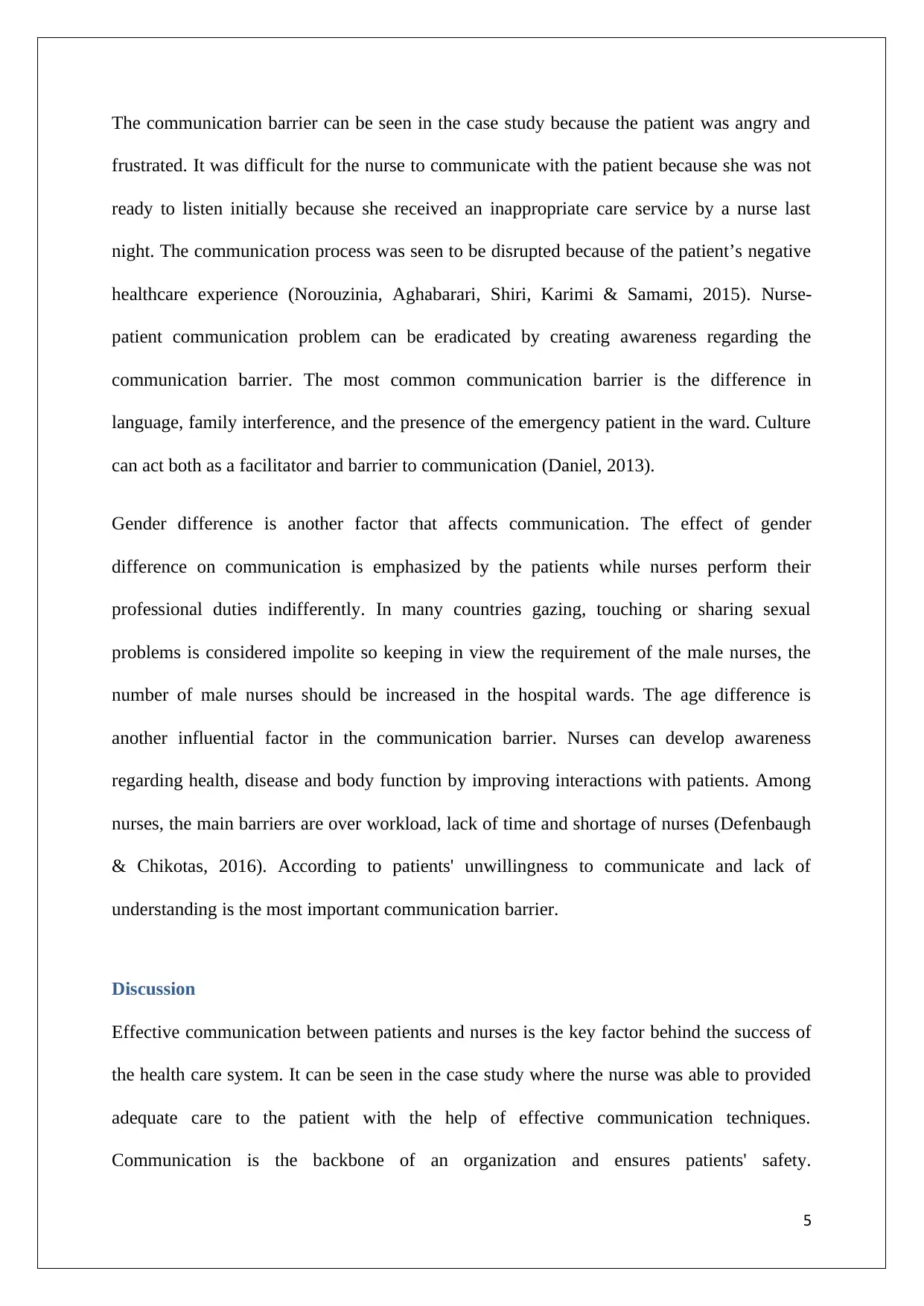
The communication barrier can be seen in the case study because the patient was angry and
frustrated. It was difficult for the nurse to communicate with the patient because she was not
ready to listen initially because she received an inappropriate care service by a nurse last
night. The communication process was seen to be disrupted because of the patient’s negative
healthcare experience (Norouzinia, Aghabarari, Shiri, Karimi & Samami, 2015). Nurse-
patient communication problem can be eradicated by creating awareness regarding the
communication barrier. The most common communication barrier is the difference in
language, family interference, and the presence of the emergency patient in the ward. Culture
can act both as a facilitator and barrier to communication (Daniel, 2013).
Gender difference is another factor that affects communication. The effect of gender
difference on communication is emphasized by the patients while nurses perform their
professional duties indifferently. In many countries gazing, touching or sharing sexual
problems is considered impolite so keeping in view the requirement of the male nurses, the
number of male nurses should be increased in the hospital wards. The age difference is
another influential factor in the communication barrier. Nurses can develop awareness
regarding health, disease and body function by improving interactions with patients. Among
nurses, the main barriers are over workload, lack of time and shortage of nurses (Defenbaugh
& Chikotas, 2016). According to patients' unwillingness to communicate and lack of
understanding is the most important communication barrier.
Discussion
Effective communication between patients and nurses is the key factor behind the success of
the health care system. It can be seen in the case study where the nurse was able to provided
adequate care to the patient with the help of effective communication techniques.
Communication is the backbone of an organization and ensures patients' safety.
5
frustrated. It was difficult for the nurse to communicate with the patient because she was not
ready to listen initially because she received an inappropriate care service by a nurse last
night. The communication process was seen to be disrupted because of the patient’s negative
healthcare experience (Norouzinia, Aghabarari, Shiri, Karimi & Samami, 2015). Nurse-
patient communication problem can be eradicated by creating awareness regarding the
communication barrier. The most common communication barrier is the difference in
language, family interference, and the presence of the emergency patient in the ward. Culture
can act both as a facilitator and barrier to communication (Daniel, 2013).
Gender difference is another factor that affects communication. The effect of gender
difference on communication is emphasized by the patients while nurses perform their
professional duties indifferently. In many countries gazing, touching or sharing sexual
problems is considered impolite so keeping in view the requirement of the male nurses, the
number of male nurses should be increased in the hospital wards. The age difference is
another influential factor in the communication barrier. Nurses can develop awareness
regarding health, disease and body function by improving interactions with patients. Among
nurses, the main barriers are over workload, lack of time and shortage of nurses (Defenbaugh
& Chikotas, 2016). According to patients' unwillingness to communicate and lack of
understanding is the most important communication barrier.
Discussion
Effective communication between patients and nurses is the key factor behind the success of
the health care system. It can be seen in the case study where the nurse was able to provided
adequate care to the patient with the help of effective communication techniques.
Communication is the backbone of an organization and ensures patients' safety.
5
⊘ This is a preview!⊘
Do you want full access?
Subscribe today to unlock all pages.

Trusted by 1+ million students worldwide
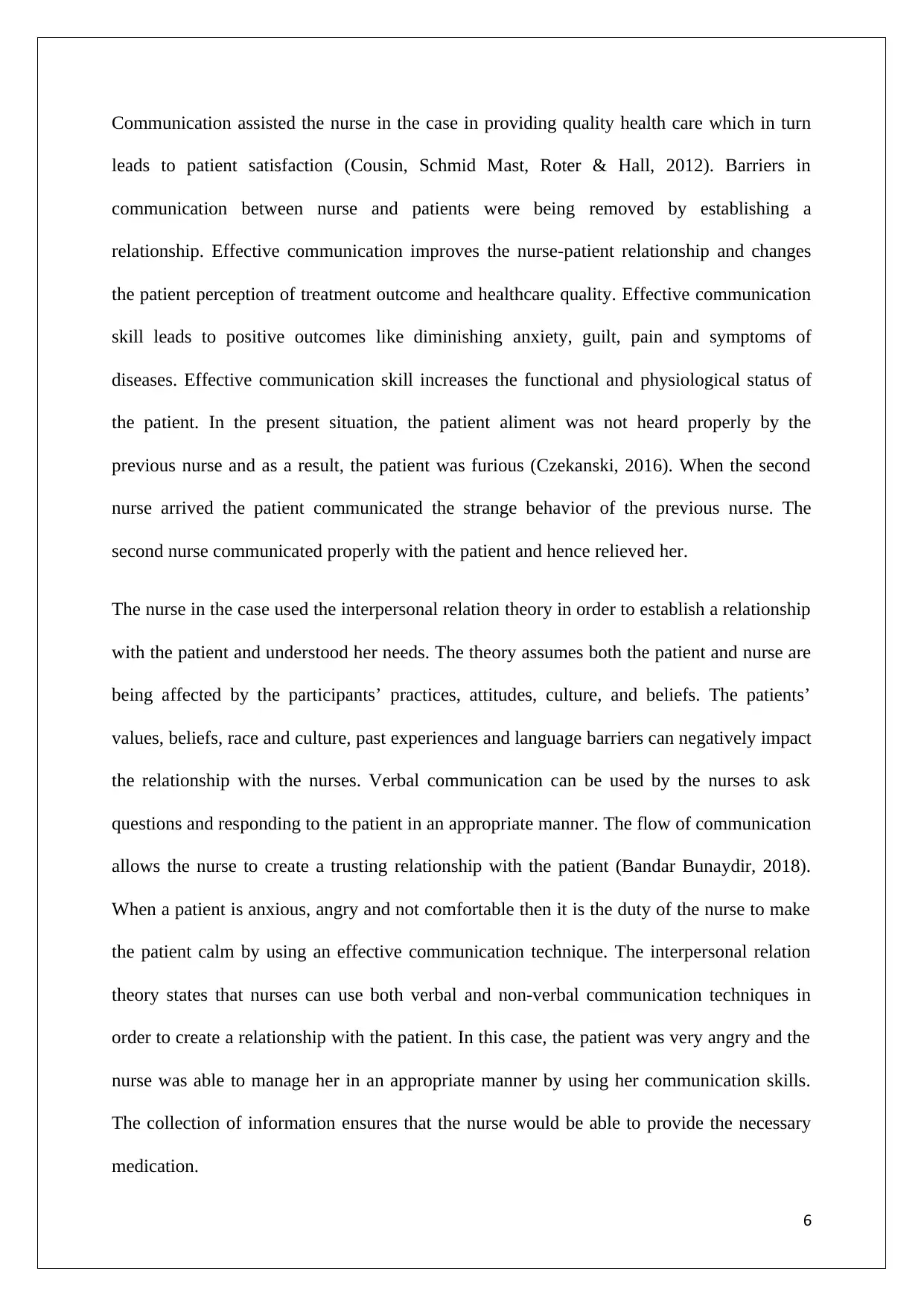
Communication assisted the nurse in the case in providing quality health care which in turn
leads to patient satisfaction (Cousin, Schmid Mast, Roter & Hall, 2012). Barriers in
communication between nurse and patients were being removed by establishing a
relationship. Effective communication improves the nurse-patient relationship and changes
the patient perception of treatment outcome and healthcare quality. Effective communication
skill leads to positive outcomes like diminishing anxiety, guilt, pain and symptoms of
diseases. Effective communication skill increases the functional and physiological status of
the patient. In the present situation, the patient aliment was not heard properly by the
previous nurse and as a result, the patient was furious (Czekanski, 2016). When the second
nurse arrived the patient communicated the strange behavior of the previous nurse. The
second nurse communicated properly with the patient and hence relieved her.
The nurse in the case used the interpersonal relation theory in order to establish a relationship
with the patient and understood her needs. The theory assumes both the patient and nurse are
being affected by the participants’ practices, attitudes, culture, and beliefs. The patients’
values, beliefs, race and culture, past experiences and language barriers can negatively impact
the relationship with the nurses. Verbal communication can be used by the nurses to ask
questions and responding to the patient in an appropriate manner. The flow of communication
allows the nurse to create a trusting relationship with the patient (Bandar Bunaydir, 2018).
When a patient is anxious, angry and not comfortable then it is the duty of the nurse to make
the patient calm by using an effective communication technique. The interpersonal relation
theory states that nurses can use both verbal and non-verbal communication techniques in
order to create a relationship with the patient. In this case, the patient was very angry and the
nurse was able to manage her in an appropriate manner by using her communication skills.
The collection of information ensures that the nurse would be able to provide the necessary
medication.
6
leads to patient satisfaction (Cousin, Schmid Mast, Roter & Hall, 2012). Barriers in
communication between nurse and patients were being removed by establishing a
relationship. Effective communication improves the nurse-patient relationship and changes
the patient perception of treatment outcome and healthcare quality. Effective communication
skill leads to positive outcomes like diminishing anxiety, guilt, pain and symptoms of
diseases. Effective communication skill increases the functional and physiological status of
the patient. In the present situation, the patient aliment was not heard properly by the
previous nurse and as a result, the patient was furious (Czekanski, 2016). When the second
nurse arrived the patient communicated the strange behavior of the previous nurse. The
second nurse communicated properly with the patient and hence relieved her.
The nurse in the case used the interpersonal relation theory in order to establish a relationship
with the patient and understood her needs. The theory assumes both the patient and nurse are
being affected by the participants’ practices, attitudes, culture, and beliefs. The patients’
values, beliefs, race and culture, past experiences and language barriers can negatively impact
the relationship with the nurses. Verbal communication can be used by the nurses to ask
questions and responding to the patient in an appropriate manner. The flow of communication
allows the nurse to create a trusting relationship with the patient (Bandar Bunaydir, 2018).
When a patient is anxious, angry and not comfortable then it is the duty of the nurse to make
the patient calm by using an effective communication technique. The interpersonal relation
theory states that nurses can use both verbal and non-verbal communication techniques in
order to create a relationship with the patient. In this case, the patient was very angry and the
nurse was able to manage her in an appropriate manner by using her communication skills.
The collection of information ensures that the nurse would be able to provide the necessary
medication.
6
Paraphrase This Document
Need a fresh take? Get an instant paraphrase of this document with our AI Paraphraser
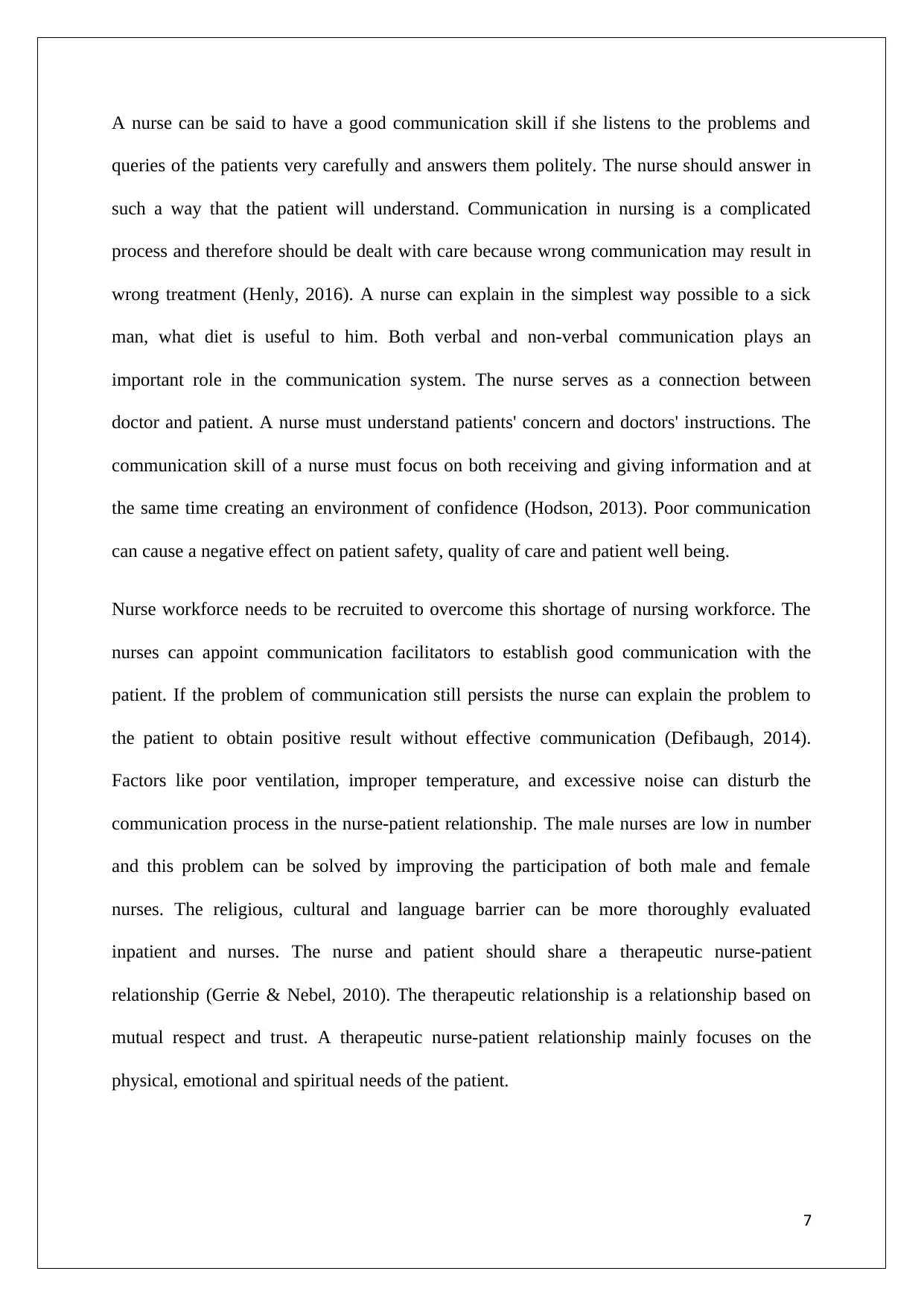
A nurse can be said to have a good communication skill if she listens to the problems and
queries of the patients very carefully and answers them politely. The nurse should answer in
such a way that the patient will understand. Communication in nursing is a complicated
process and therefore should be dealt with care because wrong communication may result in
wrong treatment (Henly, 2016). A nurse can explain in the simplest way possible to a sick
man, what diet is useful to him. Both verbal and non-verbal communication plays an
important role in the communication system. The nurse serves as a connection between
doctor and patient. A nurse must understand patients' concern and doctors' instructions. The
communication skill of a nurse must focus on both receiving and giving information and at
the same time creating an environment of confidence (Hodson, 2013). Poor communication
can cause a negative effect on patient safety, quality of care and patient well being.
Nurse workforce needs to be recruited to overcome this shortage of nursing workforce. The
nurses can appoint communication facilitators to establish good communication with the
patient. If the problem of communication still persists the nurse can explain the problem to
the patient to obtain positive result without effective communication (Defibaugh, 2014).
Factors like poor ventilation, improper temperature, and excessive noise can disturb the
communication process in the nurse-patient relationship. The male nurses are low in number
and this problem can be solved by improving the participation of both male and female
nurses. The religious, cultural and language barrier can be more thoroughly evaluated
inpatient and nurses. The nurse and patient should share a therapeutic nurse-patient
relationship (Gerrie & Nebel, 2010). The therapeutic relationship is a relationship based on
mutual respect and trust. A therapeutic nurse-patient relationship mainly focuses on the
physical, emotional and spiritual needs of the patient.
7
queries of the patients very carefully and answers them politely. The nurse should answer in
such a way that the patient will understand. Communication in nursing is a complicated
process and therefore should be dealt with care because wrong communication may result in
wrong treatment (Henly, 2016). A nurse can explain in the simplest way possible to a sick
man, what diet is useful to him. Both verbal and non-verbal communication plays an
important role in the communication system. The nurse serves as a connection between
doctor and patient. A nurse must understand patients' concern and doctors' instructions. The
communication skill of a nurse must focus on both receiving and giving information and at
the same time creating an environment of confidence (Hodson, 2013). Poor communication
can cause a negative effect on patient safety, quality of care and patient well being.
Nurse workforce needs to be recruited to overcome this shortage of nursing workforce. The
nurses can appoint communication facilitators to establish good communication with the
patient. If the problem of communication still persists the nurse can explain the problem to
the patient to obtain positive result without effective communication (Defibaugh, 2014).
Factors like poor ventilation, improper temperature, and excessive noise can disturb the
communication process in the nurse-patient relationship. The male nurses are low in number
and this problem can be solved by improving the participation of both male and female
nurses. The religious, cultural and language barrier can be more thoroughly evaluated
inpatient and nurses. The nurse and patient should share a therapeutic nurse-patient
relationship (Gerrie & Nebel, 2010). The therapeutic relationship is a relationship based on
mutual respect and trust. A therapeutic nurse-patient relationship mainly focuses on the
physical, emotional and spiritual needs of the patient.
7
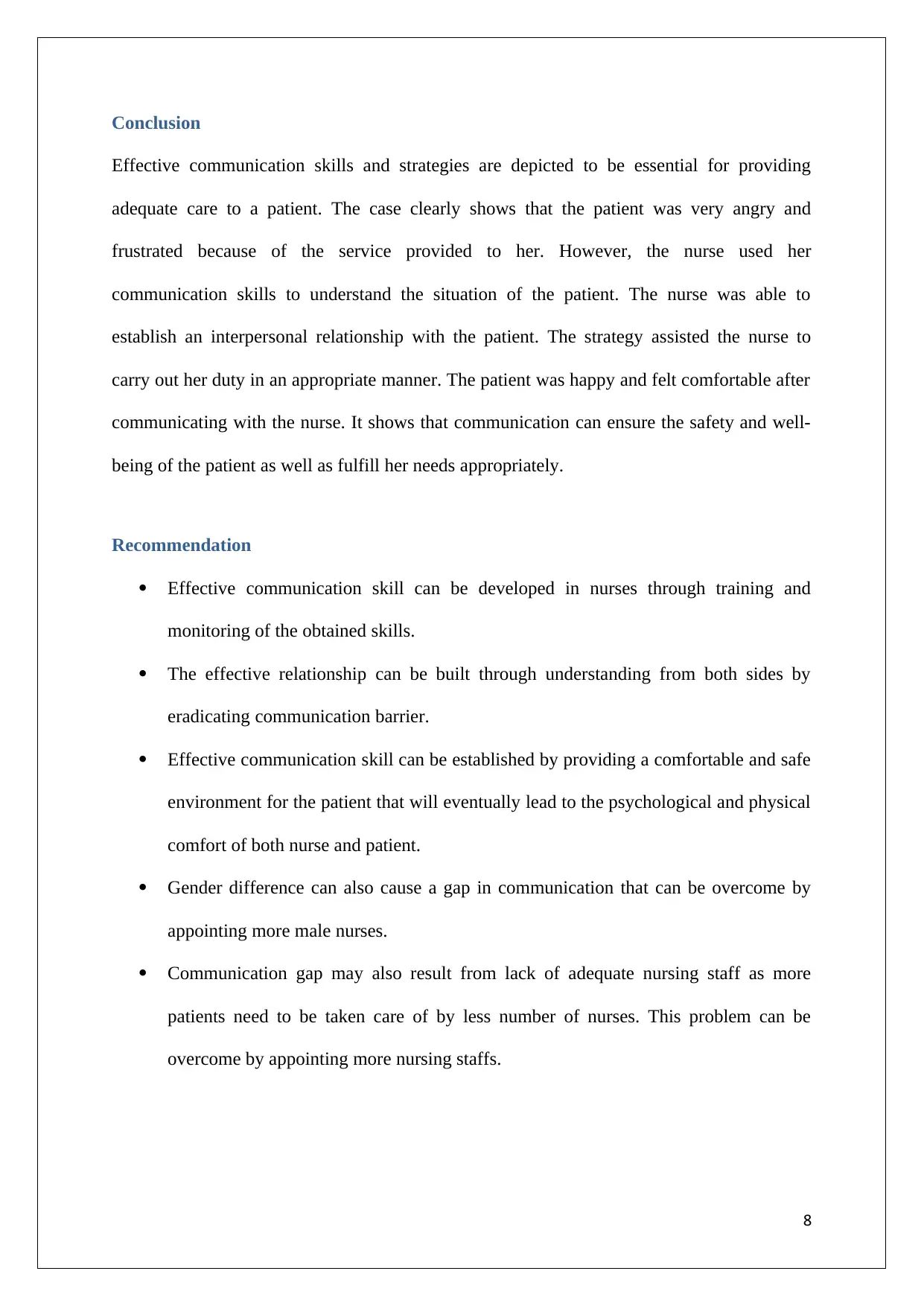
Conclusion
Effective communication skills and strategies are depicted to be essential for providing
adequate care to a patient. The case clearly shows that the patient was very angry and
frustrated because of the service provided to her. However, the nurse used her
communication skills to understand the situation of the patient. The nurse was able to
establish an interpersonal relationship with the patient. The strategy assisted the nurse to
carry out her duty in an appropriate manner. The patient was happy and felt comfortable after
communicating with the nurse. It shows that communication can ensure the safety and well-
being of the patient as well as fulfill her needs appropriately.
Recommendation
Effective communication skill can be developed in nurses through training and
monitoring of the obtained skills.
The effective relationship can be built through understanding from both sides by
eradicating communication barrier.
Effective communication skill can be established by providing a comfortable and safe
environment for the patient that will eventually lead to the psychological and physical
comfort of both nurse and patient.
Gender difference can also cause a gap in communication that can be overcome by
appointing more male nurses.
Communication gap may also result from lack of adequate nursing staff as more
patients need to be taken care of by less number of nurses. This problem can be
overcome by appointing more nursing staffs.
8
Effective communication skills and strategies are depicted to be essential for providing
adequate care to a patient. The case clearly shows that the patient was very angry and
frustrated because of the service provided to her. However, the nurse used her
communication skills to understand the situation of the patient. The nurse was able to
establish an interpersonal relationship with the patient. The strategy assisted the nurse to
carry out her duty in an appropriate manner. The patient was happy and felt comfortable after
communicating with the nurse. It shows that communication can ensure the safety and well-
being of the patient as well as fulfill her needs appropriately.
Recommendation
Effective communication skill can be developed in nurses through training and
monitoring of the obtained skills.
The effective relationship can be built through understanding from both sides by
eradicating communication barrier.
Effective communication skill can be established by providing a comfortable and safe
environment for the patient that will eventually lead to the psychological and physical
comfort of both nurse and patient.
Gender difference can also cause a gap in communication that can be overcome by
appointing more male nurses.
Communication gap may also result from lack of adequate nursing staff as more
patients need to be taken care of by less number of nurses. This problem can be
overcome by appointing more nursing staffs.
8
⊘ This is a preview!⊘
Do you want full access?
Subscribe today to unlock all pages.

Trusted by 1+ million students worldwide
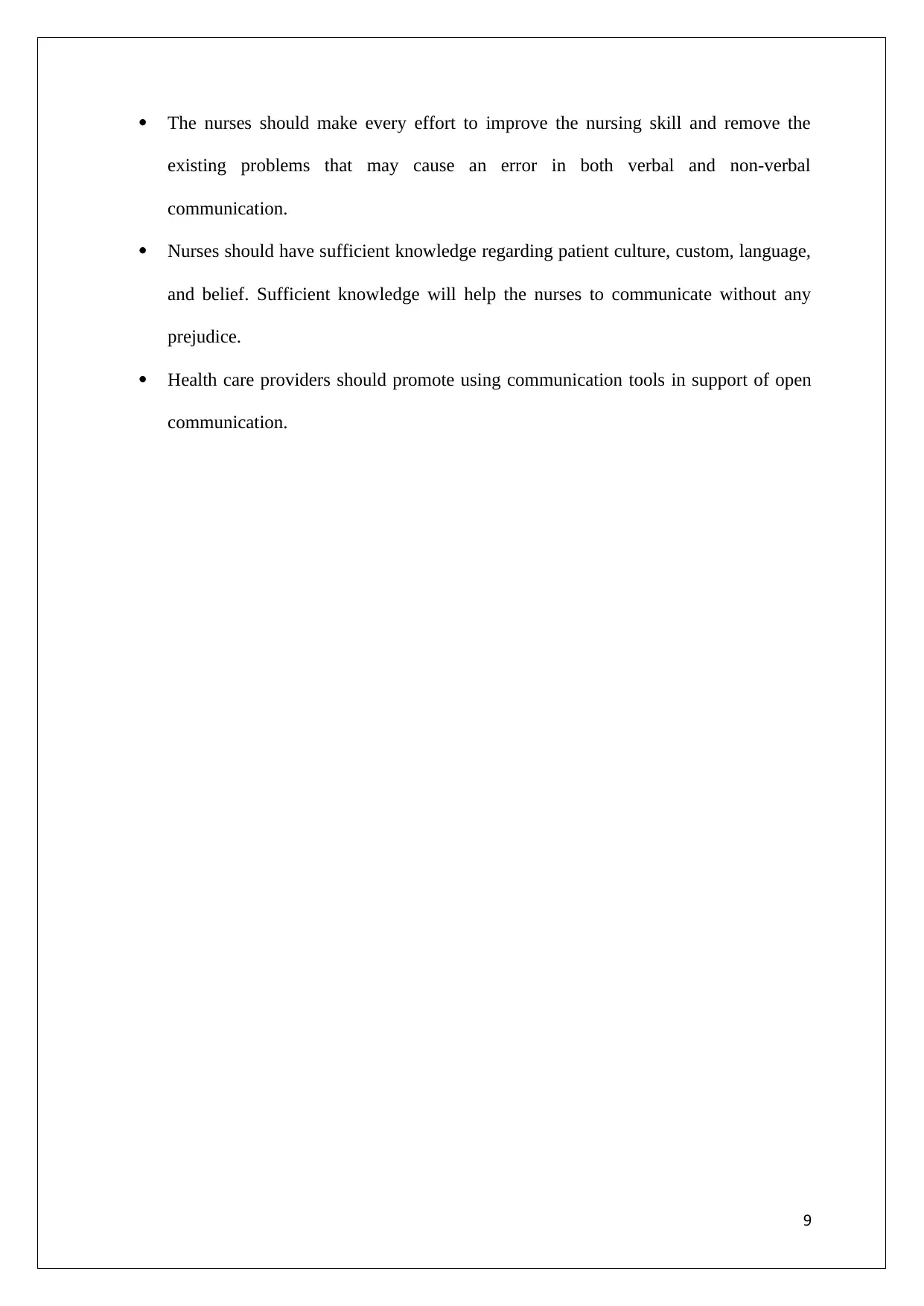
The nurses should make every effort to improve the nursing skill and remove the
existing problems that may cause an error in both verbal and non-verbal
communication.
Nurses should have sufficient knowledge regarding patient culture, custom, language,
and belief. Sufficient knowledge will help the nurses to communicate without any
prejudice.
Health care providers should promote using communication tools in support of open
communication.
9
existing problems that may cause an error in both verbal and non-verbal
communication.
Nurses should have sufficient knowledge regarding patient culture, custom, language,
and belief. Sufficient knowledge will help the nurses to communicate without any
prejudice.
Health care providers should promote using communication tools in support of open
communication.
9
Paraphrase This Document
Need a fresh take? Get an instant paraphrase of this document with our AI Paraphraser
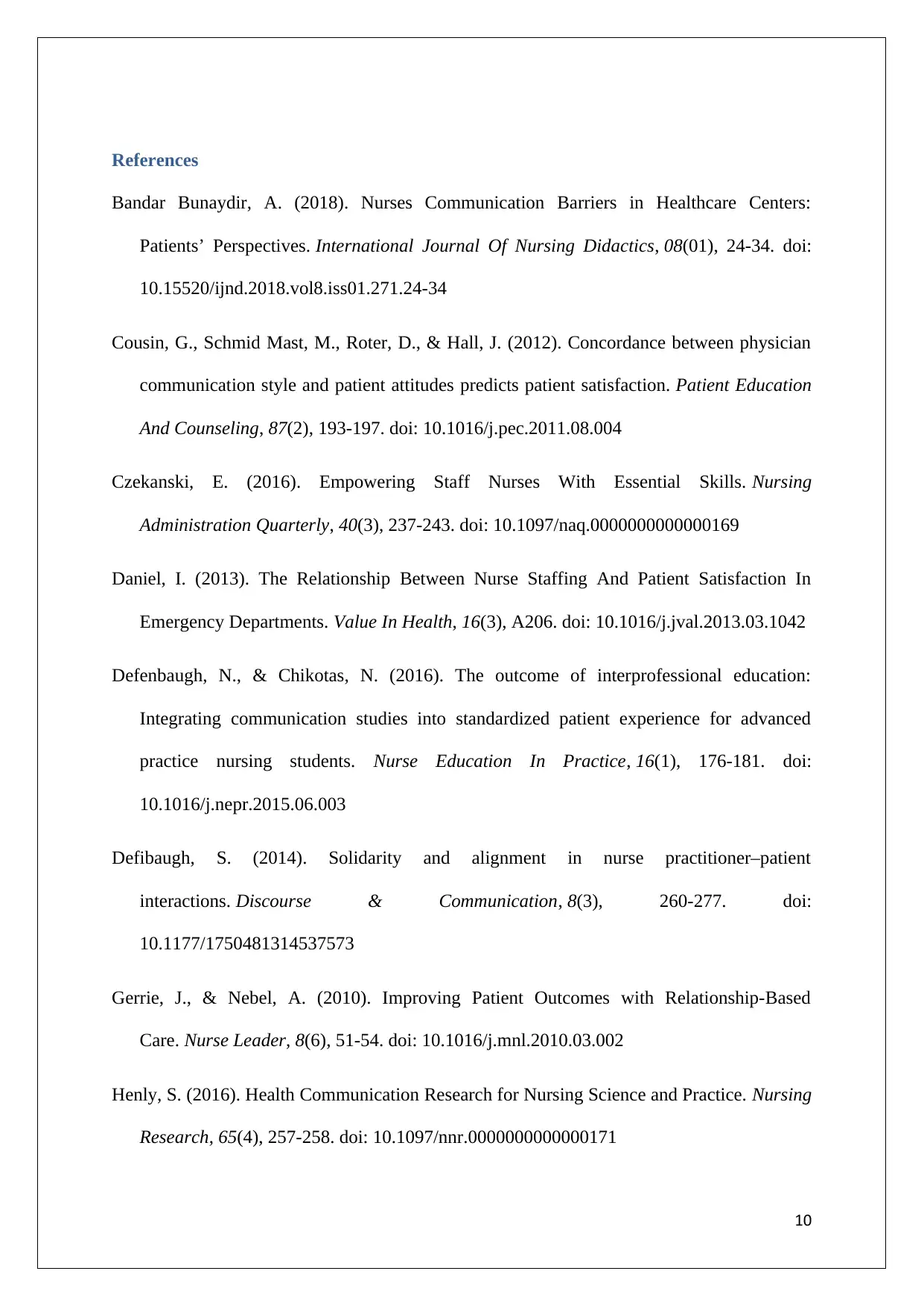
References
Bandar Bunaydir, A. (2018). Nurses Communication Barriers in Healthcare Centers:
Patients’ Perspectives. International Journal Of Nursing Didactics, 08(01), 24-34. doi:
10.15520/ijnd.2018.vol8.iss01.271.24-34
Cousin, G., Schmid Mast, M., Roter, D., & Hall, J. (2012). Concordance between physician
communication style and patient attitudes predicts patient satisfaction. Patient Education
And Counseling, 87(2), 193-197. doi: 10.1016/j.pec.2011.08.004
Czekanski, E. (2016). Empowering Staff Nurses With Essential Skills. Nursing
Administration Quarterly, 40(3), 237-243. doi: 10.1097/naq.0000000000000169
Daniel, I. (2013). The Relationship Between Nurse Staffing And Patient Satisfaction In
Emergency Departments. Value In Health, 16(3), A206. doi: 10.1016/j.jval.2013.03.1042
Defenbaugh, N., & Chikotas, N. (2016). The outcome of interprofessional education:
Integrating communication studies into standardized patient experience for advanced
practice nursing students. Nurse Education In Practice, 16(1), 176-181. doi:
10.1016/j.nepr.2015.06.003
Defibaugh, S. (2014). Solidarity and alignment in nurse practitioner–patient
interactions. Discourse & Communication, 8(3), 260-277. doi:
10.1177/1750481314537573
Gerrie, J., & Nebel, A. (2010). Improving Patient Outcomes with Relationship-Based
Care. Nurse Leader, 8(6), 51-54. doi: 10.1016/j.mnl.2010.03.002
Henly, S. (2016). Health Communication Research for Nursing Science and Practice. Nursing
Research, 65(4), 257-258. doi: 10.1097/nnr.0000000000000171
10
Bandar Bunaydir, A. (2018). Nurses Communication Barriers in Healthcare Centers:
Patients’ Perspectives. International Journal Of Nursing Didactics, 08(01), 24-34. doi:
10.15520/ijnd.2018.vol8.iss01.271.24-34
Cousin, G., Schmid Mast, M., Roter, D., & Hall, J. (2012). Concordance between physician
communication style and patient attitudes predicts patient satisfaction. Patient Education
And Counseling, 87(2), 193-197. doi: 10.1016/j.pec.2011.08.004
Czekanski, E. (2016). Empowering Staff Nurses With Essential Skills. Nursing
Administration Quarterly, 40(3), 237-243. doi: 10.1097/naq.0000000000000169
Daniel, I. (2013). The Relationship Between Nurse Staffing And Patient Satisfaction In
Emergency Departments. Value In Health, 16(3), A206. doi: 10.1016/j.jval.2013.03.1042
Defenbaugh, N., & Chikotas, N. (2016). The outcome of interprofessional education:
Integrating communication studies into standardized patient experience for advanced
practice nursing students. Nurse Education In Practice, 16(1), 176-181. doi:
10.1016/j.nepr.2015.06.003
Defibaugh, S. (2014). Solidarity and alignment in nurse practitioner–patient
interactions. Discourse & Communication, 8(3), 260-277. doi:
10.1177/1750481314537573
Gerrie, J., & Nebel, A. (2010). Improving Patient Outcomes with Relationship-Based
Care. Nurse Leader, 8(6), 51-54. doi: 10.1016/j.mnl.2010.03.002
Henly, S. (2016). Health Communication Research for Nursing Science and Practice. Nursing
Research, 65(4), 257-258. doi: 10.1097/nnr.0000000000000171
10
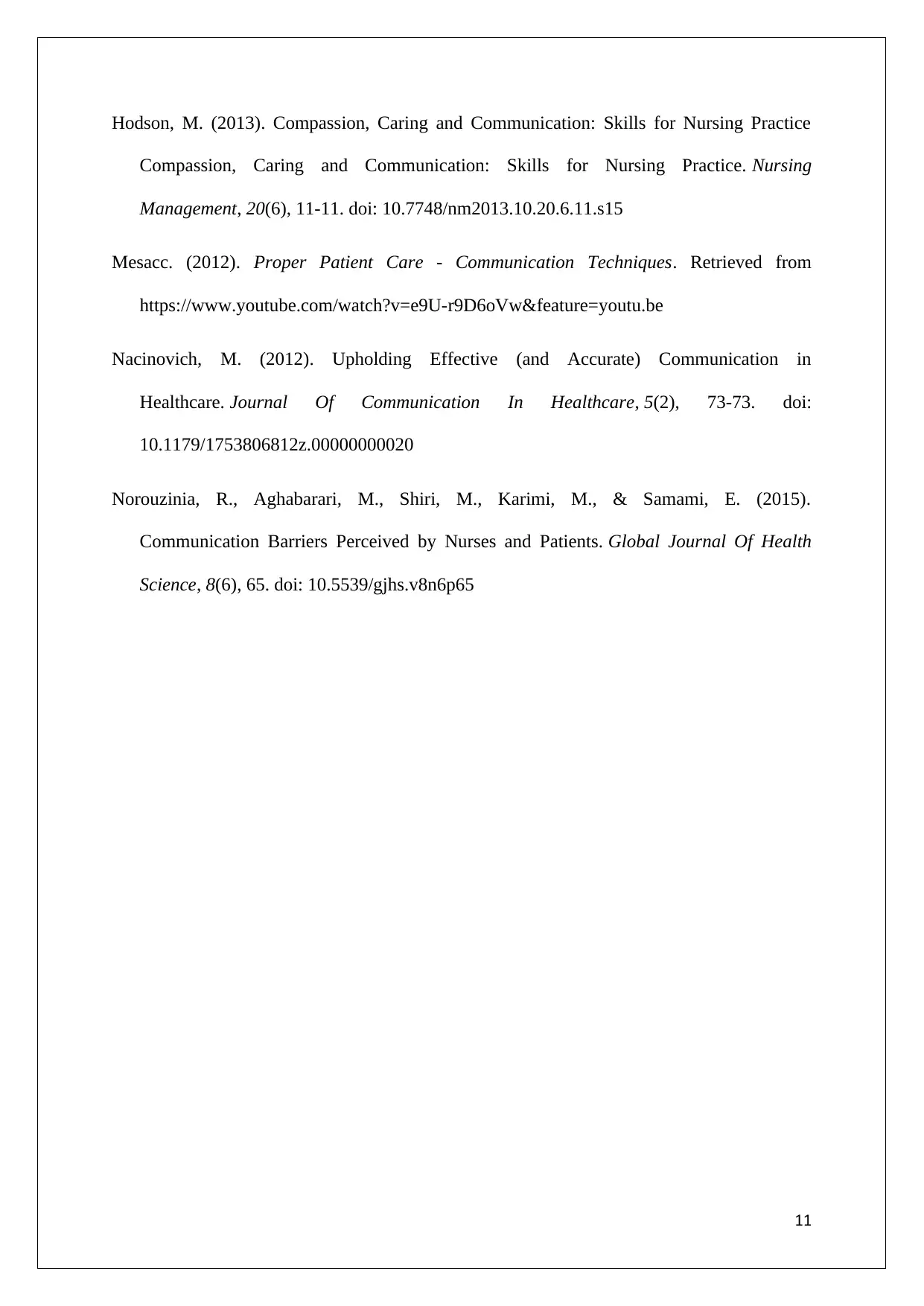
Hodson, M. (2013). Compassion, Caring and Communication: Skills for Nursing Practice
Compassion, Caring and Communication: Skills for Nursing Practice. Nursing
Management, 20(6), 11-11. doi: 10.7748/nm2013.10.20.6.11.s15
Mesacc. (2012). Proper Patient Care - Communication Techniques. Retrieved from
https://www.youtube.com/watch?v=e9U-r9D6oVw&feature=youtu.be
Nacinovich, M. (2012). Upholding Effective (and Accurate) Communication in
Healthcare. Journal Of Communication In Healthcare, 5(2), 73-73. doi:
10.1179/1753806812z.00000000020
Norouzinia, R., Aghabarari, M., Shiri, M., Karimi, M., & Samami, E. (2015).
Communication Barriers Perceived by Nurses and Patients. Global Journal Of Health
Science, 8(6), 65. doi: 10.5539/gjhs.v8n6p65
11
Compassion, Caring and Communication: Skills for Nursing Practice. Nursing
Management, 20(6), 11-11. doi: 10.7748/nm2013.10.20.6.11.s15
Mesacc. (2012). Proper Patient Care - Communication Techniques. Retrieved from
https://www.youtube.com/watch?v=e9U-r9D6oVw&feature=youtu.be
Nacinovich, M. (2012). Upholding Effective (and Accurate) Communication in
Healthcare. Journal Of Communication In Healthcare, 5(2), 73-73. doi:
10.1179/1753806812z.00000000020
Norouzinia, R., Aghabarari, M., Shiri, M., Karimi, M., & Samami, E. (2015).
Communication Barriers Perceived by Nurses and Patients. Global Journal Of Health
Science, 8(6), 65. doi: 10.5539/gjhs.v8n6p65
11
⊘ This is a preview!⊘
Do you want full access?
Subscribe today to unlock all pages.

Trusted by 1+ million students worldwide
1 out of 12
Related Documents
Your All-in-One AI-Powered Toolkit for Academic Success.
+13062052269
info@desklib.com
Available 24*7 on WhatsApp / Email
![[object Object]](/_next/static/media/star-bottom.7253800d.svg)
Unlock your academic potential
Copyright © 2020–2025 A2Z Services. All Rights Reserved. Developed and managed by ZUCOL.





